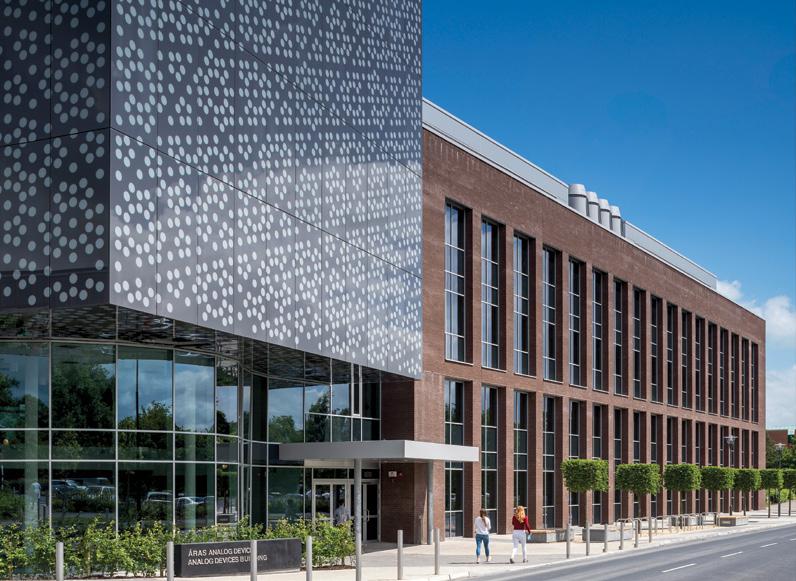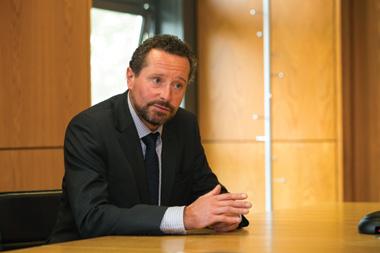
14 minute read
2020 BY THE NUMBERS
Interview with Bernal Chair of Pharmaceutical Powder Engineering, Co-Director SSPC, SFI Research Centre for Pharmaceuticals, Professor Gavin Walker
Q: You are a recognised world leading scientist, you have achieved exceptional scientific outputs in process innovation and advanced manufacturing along with funding awards in excess of €26 million, why did you choose to join the Bernal Institute?
Advertisement
I was the first Bernal Professor, appointed in July 2012. Previously I was head of chemical engineering, in a Russel group university in the UK. I moved to Bernal as it offered a great opportunity for me to focus more on research, particularly industrially relevant research in national research centres SSPC, PMTC, DPTC and CONFIRM, which are hosted in UL.
SSPC “SFI’s Research Centre for Pharmaceuticals” successfully funded and started SSPC Phase 2 in June 2019, €61M (2019-2025). EI Pharmaceutical Manufacturing Technology Centre successfully funded and started Phase 2 in July 2019, €6M (2019-2024). EI Dairy Processing Technology Centre successfully funded for Phase 2 in Q4 2019, research programme to commence Q2 2020, €23M (20202025). PROCESS: “Engineering Solutions for the Process Industry” is a MCSA Co-fund programme, supported by the European Commission and matching funds from national agencies: SFI and Enterprise Ireland, through research and technology centres DPTC, PMTC, SSPC and CONFIRM. PROCESS has recruited 9 experienced international researchers for 2-year fellowships hosted at the Bernal Institute. Several new academics joined the process cluster since 2019, Dr Luis Padrela, Dr Vasanth Kannuchamy, Dr Matthias Vandichel, Dr Orest Shardt, Dr Ahmad Albadarin and Dr Saeed Shirazian, which has contributed to the young, dynamic culture with the majority of the membership comprising of LBB, Lecturers and self-funding post-doctoral researchers.
A patent application (Application Number: EP19218890.2, Smart Flow Aids for Cohesive Powder Handling) by Dr Akeem Olaleye, Professor Gavin M. Walker, and Professor Harry van den Akker of the Bernal Institute, was filed on December 20, 2019. The filed patent relates to novel flow-aided pipe bend for conveying cohesive powders to produce an optimized bend design in industrial pipework systems. The patent arises from research by the investigators in the Enterprise Ireland funded Dairy Processing Technology Centre (DPTC) and Dr Olaleye’s 2019 SFI TIDA award on “Smart Flow Aids”. The technology builds on the novel coupling of computational fluid mechanics (CFD) and discrete element methods (DEM) mathematical models to create a “digital twin” of the nature of powder flow in a pipework geometry. The technique was used to redesign a solids handling system in a DPTC member company and was a major commercial output for DPTC. The technique is now being employed in a new project with Nestle, Corporate R&D in Switzerland, which is fully funded by industry and forms a core technology for CONFIRM, the SFI Centre for Smart Manufacturing.
Professor Gavin Walker

In 2021 the Process Engineering cluster aims to submit ERC applications in Starting (Dr Saeed Shirazian), Consolidating (Dr Ahmad Albadarin) and Advanced (Professor Gavin Walker) Awards. The cluster will also focus on developing the research programmes of SSPC, CONFIRM, PMTC and DPTC specifically on “Targeted” projects with industrial partners. The cluster will aim to establish PhD co-supervision studentships between established and junior academic members of the group. The MSCA Co-Fund “PROCESS” has received its second cohort of fellows in Q1 2020 and Call 3 has been launched in Q1 2021 for the remaining fellowships. The programme will also be hosting a summer school for the existing fellows with other MSCA Co-Fund programmes in Lero and CONFIRM at UL. The cluster will focus on increasing the quality and quantity of publications in high impact process engineering journals specifically focussing on top decile journals. The ultimate goal of the cluster in 2021 is to consolidate the membership, particularly ensuring that support is given to junior cluster members through a new SSPC-Bernal PhD scholarship scheme with the UL Foundation.
For several years, my research group has worked on mechanochemistry, which involves reactions in the solid state, with little or no solvents. The research challenge is the creation of predictive chemical engineering mathematical models for this mechanochemical synthesis. The overall ambition of this research is to unlock the industrial potential of mechanochemistry to enable more efficient and greener routes for chemical synthesis, which is a central UN Sustainable Development Goal.


Cracking the code for continuous processing and personalised medicine
Personalised medicine is the next great global challenge for the pharmaceutical industry. The vision of the pharmacy of the future is one in which pharmacies employ disruptive technologies to enable on-demand manufacture of drugs designed to individual needs. For example, multiple medications may be prescribed that treat a patient’s exact ageprofile and medical history. These medications could then be 3D printed into one tablet, ondemand at the patient’s local drug supplier.
Central to this vision is the concept of continuous processing. Currently, active pharmaceutical ingredients (APIs) are manufactured in large batches at distinctly separate times. Continuous processing replaces this large-batch process with the manufacture of lower volumes but at a constant rate. This process enables the continuous flow of product, reduces inventories, and has less batch-to-batch variation, giving higher process control and higher quality. The Process Engineering Cluster, (PROC) are changing how we train chemical engineers, impacting industry competitiveness, and attracting R&D investment into Ireland. The Process Engineering Lab at the Bernal Institute is the only academic lab in Ireland with an industrial scale, fully ventilated laboratory space and state-ofthe art analytical equipment. Both wet and dry chemistry facilities are available and the lab operates industry-standard quality systems (to the 5S methodology). In this environment, industry can be confident the solutions provided meet global standards. In addition, the availability of industrial-size equipment ensures that solutions are brought quickly to the factory-floor.
Process analytical technology and modelling is used by PROC to foster a fuller understanding of the process and to control outputs. The cluster aims to cut the capital and operation costs of processes in half. This will have the effect of enabling millions of new patients in emerging markets and the developing world to benefit from the dramatically improved availability of medicine and nutrition (health) and worldwide access to affordable clean energy. Furthermore, the cluster aims to reduce the waste generation and net energy consumption of manufacturing processes by 2.5% year on year for five years, which will mean that Irish and European (carbon) emission targets are met, leading to a substantial contribution to reducing global warming.



Senior Research Fellow, PMTC, Dr David Egan
BIO MATERIALS CLUSTER
Total Publications in 2020: 100* Members in Cluster: 20 Cluster leader: Dr Andreas Grabrucker Deputy Leaders: Dr John Mulvihill and Dr Elizabeth Ryan *Including cross cluster publications
In the 21st century, tackling grand challenges in the area of human health and wellbeing is going through a revolution. There is a growing consensus that an integrated and holistic approach is needed to converge the understanding and diagnoses of disease processes to enable more personalised and preventive medicine. Treatments will have to be individualised because each person’s genetic code may require designing targeted molecular and cellular therapies. Diseases develop within the local structure of body parts and spread through a complex biological hierarchy, starting from the molecular building blocks towards cells, tissues and organs. Our bio-science and bio-engineering researchers work together with medical professionals to develop tools, methodologies and therapies to solve pertinent medical and healthcare problems.
We develop and apply disruptive technologies using custom designed and state-of-the-art equipment essential for the development of bioactive materials and medical devices which will in turn ensure the wellbeing and health of society.
Specific goals for BIO
1. Develop new robust and sensitive analytical technologies using organoids and other structured bio materials.
2.Develop multifunctional bio materials to deliver minimally invasive and safer therapeutic treatment and surgery, leading to higher patient comfort, greater therapeutic success and lower health cost (less follow-up surgery).
3.Develop advanced, multifunctional bio materials through modelling, targeted design and subsequent manufacturing.
Dr. Marina Steiner-Browne
Interview with Dr Andreas Grabrucker, Bio Materials Cluster Leader
Q: You are an authority in the field of genetic and non-genetic contributors to neuronal dysfunction and in the development of novel treatment strategies for brain diseases and dysfunctions, why did you choose to pursue your research in Neuroscience at the Bernal Institute?
My goal was always to perform translational research. To do this, my team and I need to be in an environment that is interdisciplinary and open to collaboration. We want to work with cell biologists, biochemists, and food scientists in fundamental research projects to develop novel model systems for brain diseases to understand molecular and cellular pathomechanisms. But we also want to work with bioengineers and pharmaceutical biotechnologists, for example, around drug delivery using nanotechnology, to use the knowledge we gain from our fundamental research and then translate this into treatment strategies by developing drugs and bio materials that can be tested immediately in our biomimetics for the diseases. This requires a broad range of expertise and equipment, which we have under one roof in the Bernal Institute, where I am not one among fifty neuroscientists that perform basic research, but where I can benefit from the expert opinions of my colleagues who have a broad range of research interest and knowledge, and who contribute so many valuable ideas.
When I joined in 2017, the Biolabs were practically empty rooms. Within an incredibly short time the Bernal Bio Labs were established, functional, fully operational and one of the best-equipped labs I have ever worked in. The Bernal Biolabs received the Irish Laboratory Award in 2020 for best Irish start-up laboratory of the year. We came from growing simple cancer cell lines to developing complex 3D organs on a chip derived from human stem cells in just a few years. Today, I can grow a miniature 3D human brain organoid in the lab; and this is just an example from my own research. I know that my colleagues have achieved similar or even more progress in their work. Through working together, sharing equipment, and our combined efforts to perform high-quality research; today, the Bio Materials Cluster is an internationally competitive research group.
The Bio Materials Cluster covers a broad area of research. We had great discoveries in many areas, from biopiezoelectricity to developing lifesaving therapies for sepsis which gained attention and attracted significant funding. Top scientific discovery is seldom owned by one Cluster. It results from an institutional, national, and/or international collaboration. The Cluster is there to support, but it is the group of researchers, inside and outside Bernal, that make the discovery. Personally, I think any invention or discovery, any scientific result that is published and becomes part of the knowledge of humanity, is important. Therefore, I am hesitant to pick and highlight one scientific discovery. Bernal Principal Investigators are all experts in their fields, many of them world-renowned researchers who make top scientific discoveries.
I want us all to be successful, and in science, this means publishing many studies in high-impact journals, receiving lots of funding, filing patents, and creating spin-out companies. Being part of a Cluster such as the Bio Materials Cluster will facilitate success, my ambition is to create a climate where every researcher, from PhD student to senior PI, finds him/herself in a community that works together towards these goals. I believe that being a scientist and researcher is more than a job; it is an attitude towards life. I would like to establish a climate where

Dr Andreas Grabrucker
we nurture scientific culture. We need to come together in Journal Clubs, seminars, and in general, we need to let the spirit of science in by creating a space where Cluster members can informally come together, chat about their work, rant on about teaching load, and most importantly, develop new ideas; whether it is Sunday or Monday, 2pm or 1 am. Hopefully, post pandemic, we will do this once again and enjoy more academic freedom. The Bernal Institute and Bio Materials Cluster should be a vibrant place to meet because this is how projects are developed and new collaborations are formed which are the basis of success in science.
Being a neuroscientist, I am in the fortunate position that so much is still unknown about the inner workings of our brain, and so many open research questions remain that I will certainly not run out of scientific goals. As a PhD student, I worked closely with patients with very rare diseases with symptoms such as autism or intellectual disability (sometimes with less than 2000 individuals affected worldwide by the disorder): apart from contributing to solving the puzzle of what causes the diseases, I would like to see my research impacting the lives of these families. Therefore, some of my research shifted towards bringing our advances in drug development and delivery to the market through commercial approaches. Last year, I won an EI commercialisation feasibility grant and I hope that I will continue to progress in this direction over the coming years. The Bio Materials cluster was established in 2017 under the leadership of Tewfik Soulimane, Chair for Molecular Structural Biology, Head of Department of Chemical Sciences and Head of the School of Natural Sciences. It boasts an impressive portfolio of characterisation and imaging technologies, modelbased analysis and design, and manufacturing technologies for a wide range of molecular bio materials. In 2020 Professor Soulimane made the decision to focus solely on leading the Department of Chemical Sciences, he remains a strong support and mentor to the cluster. The Department of Chemical Sciences is an integral part of the Bernal research institute, providing approximately 40% of its academic members.

Dr Jakki Cooney shares her journey to starting UL spin-out: Cala Medical
For the last 30 years my research team has used a multipronged approach to investigate bacterial proteases. It was a journey driven by simple curiosity – how do the proteases work? However, I believe when an opportunity to pay society back is presented through our research, we have to do it – even if you have no commercial skills. So with support from my long-suffering lab partner, Dr Todd Kagawa, and an old friend with business skills, Dr Brian Noonan, I took a step in 2013 to commercialize our work. I have heard again and again that team is key, it is. And the team was broader than the main faces involved, with support from Professor Sean Arkins, the TTO and research office, lots of colleagues in UL going out on a limb for us, being key to getting things going. We secured a 3 year €0.56 million Commercialization Fund from Enterprise Ireland which resulted in us founding Cala Medical in 2017. The company was named after the local area, Caladh an Treoigh, and invokes the concept of the sanctuary of the harbour in a storm. Based on research from the Department of Biological Sciences and the Bernal Institute, the patented technology is a first in class catalytic medical device, using an immobilized protease, ScpA to target and destroy the complement component C5a. The first indications for use are in calming the cytokine storm that occurs in sepsis, with the aspiration of improving outcomes for patients with this life threatening condition. In 2018, as Chief Scientific Officer of Cala Medical I led a consortium which was awarded over €5 million from the Irish Government’s new Disruptive Technology Innovation Fund. This funding secured approx €3 million to University of Limerick partners, including Dr Sarah Hudson, Dr Kieran McGourty and Professor Edmond Magner. The group combines my expertise in proteases with expertise in formulation and cell biology to harness the power of proteases as a new therapeutic strategy, displacing monoclonal antibody therapies across a range of inflammatory diseases. Cala Medical is now maturing as a company, and two of the founders have returned to Academia and with them a wealth of knowledge (and scars!) which hopefully will be of use to the community in the Bernal. Would I do it again? The same rule still applies, as an academic I owe my livelihood to the taxpayers of the world, if our work can save a life, do I really have a choice?
Dr Jakki Cooney


Unzipping the lipid cubic phase to release the therapeutic effect by PhD researcher, Michele Dully, Bio Materials cluster. The illustration shows the controlled release of hydrophobic pharmaceuticals. Here, the release of poorly-soluble clofazimine is shown, driven by modulated enzymatic degradation of the lipid-matrix.





